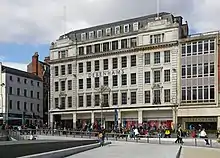Bromley and Watkins
Bromley and Watkins was an architectural practice based in Nottingham from 1912 to 1928.

130 High Street, Southend-on-Sea 1915

Former Griffin and Spalding department store, Long Row, Nottingham 1919-20 and 1927

Former National Provincial Bank, Wolverhampton
History
Albert Nelson Bromley and Harry Garnham Watkins established the practice in Nottingham in 1912.[1] Harry Garnham Watkins was the son of William Watkins, an architect from Lincoln. The partnership was dissolved in 1928[2] when Harry Garnham Watkins retired.
Works
- Boots the Chemist Factory, Station Street, Nottingham 1912[3]
- Boots the Chemist, Northgate, Gloucester 1914[4]
- Boots the Chemist, 130 High Street, Southend-on-Sea 1915[5]
- Boots the Chemist, 7 & 8 Pride Hill, Shrewsbury 1915
- Griffin & Spalding department store, Long Row, Nottingham 1919-20[6] and 1927 (later Debenhams)
- National Provincial Bank, 11 Smithy Row, Nottingham 1927-28
- National Provincial Bank, Wolverhampton
- Convalescent home for boys, Rosebery Avenue, Skegness 1928[7]
References
- Brodie, Antonia (20 December 2001). Directory of British Architects, 1834–1914: Vol 2. Royal Institute or British Architects. p. 928. ISBN 9780826455147.
- "Notice is hereby given". The London Gazette. No. 33389. 1 June 1928. p. 3811.
- "Important Commercial Scheme in Nottingham". Nottingham Evening Post. England. 21 September 1912. Retrieved 11 March 2018 – via British Newspaper Archive.
- "Shop developments in Glo'ster". Gloucestershire Chronicle. England. 9 May 1914. Retrieved 26 March 2017 – via British Newspaper Archive.
- Historic England. "130 High Street (1405205)". National Heritage List for England. Retrieved 11 March 2018.
- Harwood, Elain (1979). Pevsner Architectural Guides. Nottinghamshire. Yale University Press. p. 79. ISBN 0140710027.
- "Home for Boys". Yorkshire Post and Leeds Intelligencer. England. 31 May 1928. Retrieved 11 March 2018 – via British Newspaper Archive.
Wikimedia Commons has media related to Bromley and Watkins.
This article is issued from Wikipedia. The text is licensed under Creative Commons - Attribution - Sharealike. Additional terms may apply for the media files.